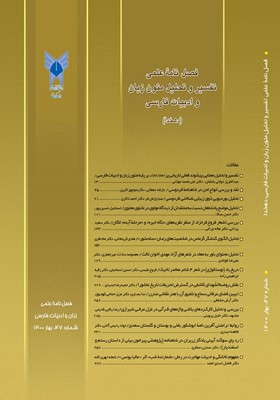نقد و بررسی انواع لحن در شاهنامه فردوسی
محورهای موضوعی : متون زبان و ادبیات فارسیعارفه دهقانی 1 , منوچهر اکبری 2 *
1 - دانشجوی دکتری گروه زبان و ادبیات فارسی (ادبیات حماسی)، دانشگاه تهران، تهران، ایران.
2 - استاد گروه زبان و ادبیات فارسی، دانشگاه تهران، تهران، ایران.
کلید واژه:
چکیده مقاله :
در این مقاله، به بررسی لحنها و ابزارهای ایجاد لحن در شاهنامه پرداختهایم. این لحنها در زمانها و شرایط و مکانهای مختلف و در مواجهه با مخاطبهای مختلف و در جایگاههای مختلف، متمایز هستند. در این بررسی، به انواع لحنها رسیدیم؛ معمولا دو لحن، همزمان با هم به کار رفته و گاهی نیز به بیش از دو لحن در یک گفتار برمیخوریم. گاهی گفتارِ یک شخصیت، با اینکه طولانی بود، تا آخر، تنها با یک یا دو لحن همراه بود. گاهی نیز گفتاری کوتاه بود ولی لحن تغییر میکرد؛ مثلا ابتدای گفتار، پرخاشگرانه بود ولی در ادامه، مهربانانه سخن میگفت و همین تغییرات بیشمار لحنها و انواع گوناگون آن در شاهنامه، سبب میشود که طولانی بودن ابیاتِ این شاهکار عظیم، ملال آور نشود و با هنر فردوسی، حتی گاهی مخاطب آن چنان تحت تاثیر لحن گفتار، قرار بگیرد که ناخودآگاه حالت چهره و نوع خواندنش تغییر کرده و با آن شخصیت همذات پنداری کند.
In this paper, we examine the tone and tools of creating tone in the Shahnameh. These are distinct in various times, situations and places and in the face of different audiences and in different positions. In this review, we got into a variety of tone, usually two-tone, at the same time used together, and sometimes we are more than two tone in a speech. Sometimes a character, although it was long, was accompanied with only one or two tune. Sometimes the speech was short, but the tone changed, for example, the beginning of speech was aggressive, but in the continuation, he spoke, and the countless variations of the tone and its various types in the Shahnameh, caused that the long-being of this great feat would not be, and with the art of Ferdowsi, even sometimes the audience This is so influenced by the speech tone, which unconsciously changes the face mode and the type of reading, and with that character is also a essence.
کتابها
احمدی،بابک (1370) ساختار و تاویل متن، چاپ اول، تهران: نشر مرکز.
حمیدیان،سعید (1383) درآمدی بر اندیشه و هنر فردوسی،چاپ دوم، تهران: ناهید.
رستگار فسایی، منصور (1380) انواع شعر فارسی، چاپ دوم، شیراز: نوید شیراز.
شفیعی کدکنی، محمدرضا (1370) موسیقی شعر، چاپ سوم، تهران: آگاه.
فردوسی، ابوالقاسم (1391) شاهنامه، به کوشش جلال خالقی مطلق، دفتر 1-8، چاپ چهارم، تهران: مرکز دائره المعارف بزرگ اسلامی.
معین، محمد (1386) فرهنگ فارسی معین، چاپ سوم، تهران: زرین.
ملاح، حسینعلی (1367) حافظ و موسیقی، چاپ سوم، تهران: هیرمند.
مندنی پور، شهریار (1389) ارواح شهرزاد، چاپ سوم، تهران: ققنوس.
میرصادقی، جمال (1386) ادبیات داستانی، چاپ پنجم، تهران: سخن.
مقالهها
رضی، احمد؛ فرهنگی، سهیلا (1395) لحن و جایگاه و نقش آن در اشعار حافظ، نامۀ فرهنگستان، دوره پانزدهم، شمارۀ 3، صص80-102.
لوئیس، لسلی (1371) عناصر داستانی، مجلۀ ادبیات داستانی، شمارۀ 2، صص26-27.
Eliot،T.S.(1975)"،On Poetry and Poets" ،New York ، Octagon Books.
_||_Books
Ahmadi, Babak (1991) Text Structure and Interpretation, First Edition, Tehran: Markaz Publishing.
Hamidian, Saeed (2004) An Introduction to Ferdowsi Thought and Art, Second Edition, Tehran: Nahid.
Rastegar Fasaei, Mansour (2001) Persian Poems, Second Edition, Shiraz: Navid Shiraz.
Shafiee Kadkani, Mohammad Reza (1991) Poetry Music, Third Edition, Tehran: Agah.
Ferdowsi, Abolghasem (2012) Shahnameh, by Jalal Khaleghi Motlagh, Book 1-8, Fourth Edition, Tehran: The Great Islamic Encyclopedia Center.
Moein, Mohammad (2007) Moein Persian Culture, third edition, Tehran: Zarrin.
Mallah, Hossein Ali (1988) Hafez and Music, Third Edition, Tehran: Helmand.
Mandanipour, Shahriar (2010) Shahrzad Ghosts, third edition, Tehran: Phoenix.
Mirsadeghi, Jamal (2007) Fiction, Fifth Edition, Tehran: Sokhan.
Articles
Razi, Ahmad; Farhangi, Soheila (2016) Tone and position and its role in Hafez's poems, Farhangistan Letter, Volume 15, Number 3, p.
Lewis, Leslie (1992) Fictional Elements, Journal of Fiction, No. 2, pp. 26-27.
Eliot, T.S. (1975), "On Poetry and Poets", New York, Octagon Books.

